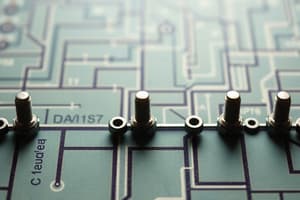Podcast
Questions and Answers
What is the purpose of using the superposition theorem in this circuit?
What is the purpose of using the superposition theorem in this circuit?
- To calculate the voltage across the resistor
- To analyze the behavior of individual sources separately (correct)
- To find the total current flowing through the circuit
- To determine the power dissipated by the capacitor
What is the significance of the phase angle of -60 degrees in the given circuit?
What is the significance of the phase angle of -60 degrees in the given circuit?
- It represents a leading current
- It signifies a purely resistive component
- It shows a capacitive reactance (correct)
- It indicates a lagging voltage
How does the impedance of a capacitor change with frequency?
How does the impedance of a capacitor change with frequency?
- Increases with increasing frequency
- Decreases with increasing frequency (correct)
- Remains constant with changing frequency
- Impedance is not affected by frequency
In the given circuit, what happens to the total current if the 30° V source is turned off?
In the given circuit, what happens to the total current if the 30° V source is turned off?
What effect does adding a resistor in series with the capacitor have on the current through the capacitor?
What effect does adding a resistor in series with the capacitor have on the current through the capacitor?
Flashcards are hidden until you start studying
Study Notes
Superposition Theorem
- The superposition theorem is used to simplify complex circuits by analyzing each source separately and then combining the results.
Phase Angle Significance
- A phase angle of -60 degrees indicates that the voltage source is lagging behind the reference angle by 60 degrees.
Capacitor Impedance and Frequency
- The impedance of a capacitor (XC) decreases as the frequency increases, following the equation XC = 1 / (2πfC), where f is the frequency and C is the capacitance.
Total Current and Circuit Modifications
- If the 30° V source is turned off, the total current in the circuit will be affected, as the total current is the phasor sum of the currents from each source.
Resistors and Capacitors in Series
- Adding a resistor in series with a capacitor will reduce the current through the capacitor, as the total impedance of the circuit (Z) increases, following the equation Z = sqrt(R^2 + XC^2), where R is the resistance and XC is the capacitive reactance.
Studying That Suits You
Use AI to generate personalized quizzes and flashcards to suit your learning preferences.




